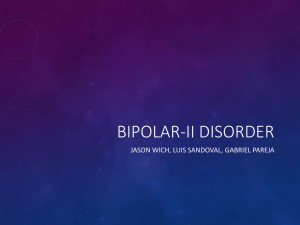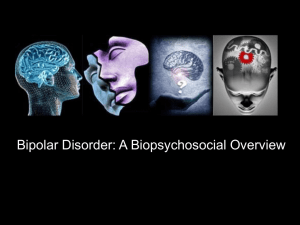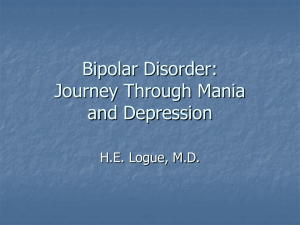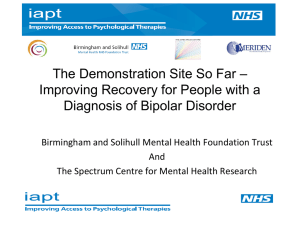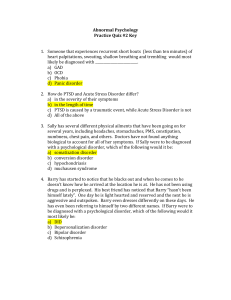Clinical Scenario - ND Center for Nursing
advertisement
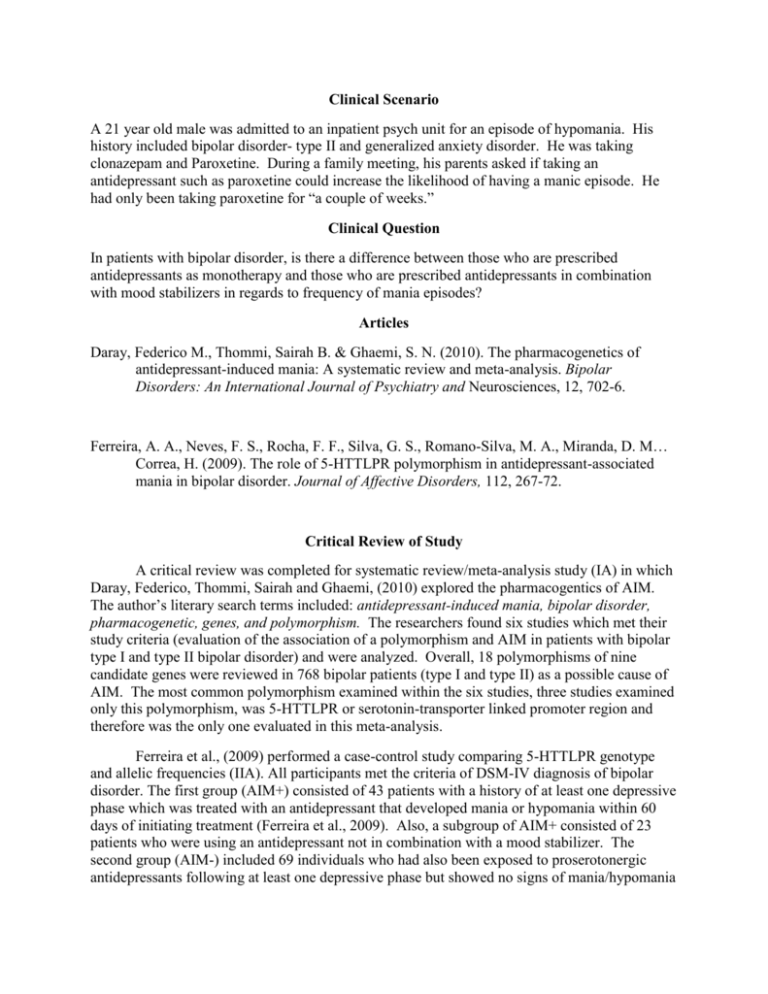
Clinical Scenario A 21 year old male was admitted to an inpatient psych unit for an episode of hypomania. His history included bipolar disorder- type II and generalized anxiety disorder. He was taking clonazepam and Paroxetine. During a family meeting, his parents asked if taking an antidepressant such as paroxetine could increase the likelihood of having a manic episode. He had only been taking paroxetine for “a couple of weeks.” Clinical Question In patients with bipolar disorder, is there a difference between those who are prescribed antidepressants as monotherapy and those who are prescribed antidepressants in combination with mood stabilizers in regards to frequency of mania episodes? Articles Daray, Federico M., Thommi, Sairah B. & Ghaemi, S. N. (2010). The pharmacogenetics of antidepressant-induced mania: A systematic review and meta-analysis. Bipolar Disorders: An International Journal of Psychiatry and Neurosciences, 12, 702-6. Ferreira, A. A., Neves, F. S., Rocha, F. F., Silva, G. S., Romano-Silva, M. A., Miranda, D. M… Correa, H. (2009). The role of 5-HTTLPR polymorphism in antidepressant-associated mania in bipolar disorder. Journal of Affective Disorders, 112, 267-72. Critical Review of Study A critical review was completed for systematic review/meta-analysis study (IA) in which Daray, Federico, Thommi, Sairah and Ghaemi, (2010) explored the pharmacogentics of AIM. The author’s literary search terms included: antidepressant-induced mania, bipolar disorder, pharmacogenetic, genes, and polymorphism. The researchers found six studies which met their study criteria (evaluation of the association of a polymorphism and AIM in patients with bipolar type I and type II bipolar disorder) and were analyzed. Overall, 18 polymorphisms of nine candidate genes were reviewed in 768 bipolar patients (type I and type II) as a possible cause of AIM. The most common polymorphism examined within the six studies, three studies examined only this polymorphism, was 5-HTTLPR or serotonin-transporter linked promoter region and therefore was the only one evaluated in this meta-analysis. Ferreira et al., (2009) performed a case-control study comparing 5-HTTLPR genotype and allelic frequencies (IIA). All participants met the criteria of DSM-IV diagnosis of bipolar disorder. The first group (AIM+) consisted of 43 patients with a history of at least one depressive phase which was treated with an antidepressant that developed mania or hypomania within 60 days of initiating treatment (Ferreira et al., 2009). Also, a subgroup of AIM+ consisted of 23 patients who were using an antidepressant not in combination with a mood stabilizer. The second group (AIM-) included 69 individuals who had also been exposed to proserotonergic antidepressants following at least one depressive phase but showed no signs of mania/hypomania ANTIDEPRESSANTS AND BIPOLAR DISORDER 2 (Ferreira et al., 2009). The subgroup to AIM- consisted of 25 patients who were also not taking a mood stabilizer along with the antidepressant. The antidepressants used in this study included venlafaxine, selective serotonin reuptake inhibitors, and tricyclics (Ferreira et al., 2009). Results The results from Daray et al. (2010) were pooled. Two of the six studies researched found a positive association between AIM and the short (s) variant of the 5-HRRLPR and one study found a positive association with s-carriers (ss and sl) (Daray et al., 2010). The analysis of the studies showed a moderation association between s-allele carriers and AIM (35% increased risk) (Daray et al., 2010). Also concluded from the researchers was the reduced risk of AIM in those with concomitant use of mood stabilizers (Daray et al., 2010). Limitations to this study include the heterogeneity, definition of AIM and types of medication used, in addition to genetic study complexities (Daray et al., 2010). To elaborate on the types of medications used, a combination of a mood stabilizer and antidepressant may not interact with the polymorphism the same way as an antidepressant alone would. Results from Ferreira et al. (2009), indicated an association between s allele of the 5HTTLPR polymorphism and AIM. They concluded that a bipolar patient taking an antidepressant while being an s allele-carrier is predisposed to AIM. This study also suggests the addition of a mood stabilizer to antidepressant therapy in hopes of modulating the genetic predisposition to AIM (Ferreira et al., 2009). Limitations to this study were the small sample size and ethnic stratification causing false-positives and false-negatives. An improvement to the study that was discussed was to use drug-naïve depressive bipolar patients receiving antidepressants and mood stabilizers as combination therapy and compare to a placebo using a double blind randomized basis (Ferreira et al., 2009). However, with respect to the patients this is not ethically feasible. Clinical Bottom Line Both studies performed by Ferreira et al. (2009) and Daray et al. (2010) reported an existing correlation between use of antidepressants and AIM in those with bipolar disorder. Those who take antidepressants for bipolar disorder and are an s allele-carrier (5-HTTLPR), only to be determined by genetic testing, are predisposed to AIM. The possible association between AIM and s allele-carriers can be hypothesized as these carriers have lower gene expression, or fewer 5-HTT sites. Explaining further, higher levels of serotonin would be present in the synaptic cleft due to the decreased reuptake (Ferreira et al., 2009). To enhance this process, the response to proserotonergic antidepressants will elicit even higher levels of synaptic serotonin. As evidenced by both Ferreira et al. (2009) and Daray et al. (2010), to reduce the risk of AIM, those s allele-carriers with bipolar disorder should use an antidepressant and a mood stabilizer. Implications for Practice Since evidence has supported an association between AIM and genetic polymorphisms, genetic testing would be beneficial in those with bipolar disorder, especially those who are being treated with an antidepressant. If a patient is an s allele-carrier (5-HTTLPR), considering the use ANTIDEPRESSANTS AND BIPOLAR DISORDER 3 of mood-stabilizers in combination with antidepressants may decrease the likelihood of AIM, but caution should still be exercised. Education provided to patients and families in regards to genetics and the effects of antidepressants would be beneficial. ANTIDEPRESSANTS AND BIPOLAR DISORDER 4 References Angeli, E., Wagner, J., Lawrick, E., Moore, K., Anderson, M., Soderlund, L., & Brizee, A. (2011, November 16). APA Headings and Seriation. Retrieved from http://owl.english.purdue.edu/owl/resource/560/16/ Daray, F. M., Thommi, S. B., & Ghaemi, S. N. (2010). The pharmacogenetics of antidepressantinduced mania: a systematic review and meta-analysis. Bipolar Disorders: An International Journal of Psychiatry and Neurosciences, 12: 702-6. Ferreira, A. A., Neves, F. S., Rocha, F. F., Silva, G. S., Romano-Silva, M. A., Miranda, D. M., … Correa, H. (2009). The role of 5-HTTLPR polymorphism in antidepressant-associated mania in bipolar disorder. Journal of Affective Disorders, 112: 267-72.



